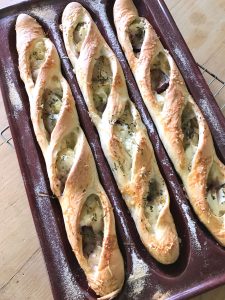In fig season we can’t get enough – juicy ripe figs stuffed with cheese, wrapped in prosciutto, roasted with honey or eaten whole in one bite if they are small enough, just delicious. These Fig, Goat Cheese and Rosemary Ficelles take advantage of fresh figs and their affinity for tart goat cheese. We serve the bread along with olives and small dishes as an appetizer. It’s also a great accompaniment to a charcuterie board or salad for a simple meal.
This firm dough holds its shape and resists bursting, which is important when you want to make a stuffed bread. It is easy to handle too, another quality that makes it suitable for stuffing. I’d be temped to make calzone from this dough too.
Ficelle means string in French. It also means a crisp wand of bread, much thinner than a baguette.
You can see how easy the dough is to work. After it ferments and rises, divide it into three pieces. Roll the pieces of dough into logs and place them on a lightly floured work surface. I use a silicone mat to keep things from sticking to my wooden worktable. Let the logs of dough sit then press them gently with your fingertips to flatten them.
Dough made from wheat flour resists rolling. It’s elastic and springs back every time you touch it. For this reason, I use a rolling pin to really flatten out each piece of dough into a strip that is wide enough to fill and fold up. (That bright pink in the photo is a silicone rolling pin.)
Sautéed onions add sweetness and flavor to the filling. Scatter the onions onto the flattened dough then top it with quartered figs and goat cheese.
This dough is easy to gather then pinch around the filling.
Once the dough is pinched and the ingredients are sealed inside, you need to gently roll the dough.
Rolling ensures that your loaves stay sealed as they bake.
Then transfer the rolled dough to an Emile Henri baguette mold or to a parchment-paper-lined sheet pan that you’ve dusted lightly with flour. It is important that the dough be positioned with its sealed side down. This helps keep the stuffed dough from bursting at the seams.
The formed and filled dough needs to proof until it expands by about 50%. This takes from 30 minutes to an hour. You score the dough to ensure it bursts open attractively while baking.
Sprinkling the dough with a little grated gruyère cheese adds flavor and a nice texture to the finished loaves.
As with all yeast breads, these loaves must cool on a wire rack to preserve their crisp crust.
And here they are, Fig, Goat Cheese and Rosemary Ficelles ready to serve.
Kitchen Notebook
The original recipe for this ficelle comes from Emile Henry. It appears in the booklet that comes with their break bakers. I tested the recipe when I tested this baguette mold for the company a few year ago. Here I adapted it to my preferred way of mixing yeast dough. And I adjusted the ingredients and fillings too.
If you don’t use a mold, simply bake the stuffed dough on a parchment-paper-lined sheet tray. And bake using steam in your oven to develop a nice crisp crust.

Fragrant rosemary and sweet figs flavor this stuffed stuffed bread. When figs are not in season, use wedges of rise peaches, plums or strawberries. This firm dough lends itself to stuffing with other cooked vegetable mixtures too. Be sure to cool any cooked filling before stuffing the dough with it.
Ingredients
1 white onion, peeled and chopped fine
4 tablespoons olive oil
2 cups (270 grams) all-purpose flour
1 teaspoon (5 grams) fine sea salt
1/2 cup + 2 tablespoons (150 grams) water
¾ teaspoon (2 grams) instant yeast
One 4-ounce log goat cheese
5–6 fresh mission figs, quartered
1 Tablespoon minced fresh rosemary
Flour for dusting
¼ cup grated Gruyere cheese
Directions
- Sauté the onion in 2 tablespoons of olive oil over low heat until softened and translucent, for about 8 – 10 minutes. Set aside.
- Combine the flour and salt in the bowl of a food processor fitted with the metal blade. Using an instant-read thermometer, adjust the water temperature so that the combined temperature of the flour and the water is the base temperature of 140°F. Add the yeast and remaining olive oil to the water. With the machine running, pour all the water through the feed tube. Process for a total of 45 seconds.
- Remove the dough from the food processor. Knead it for a minute or two on a lightly floured work surface. Roll the dough into a ball. Place it in a container, cover and let rise for 1 – 1 ½ hours.
- Preheat the oven to 480°F.
- Divide the dough into three uniform pieces. Roll each piece into a short log. Let the dough rest them roll each log of dough out into a rope measuring about 10 inches long. Flatten each rope of dough using a rolling pin until it measures about 3 – 4 inches wide and 10 inch long.
- Spread some of the onions in a strip down the center of each piece of dough leaving the edges of the dough uncovered. Place the fig quarters evenly spaced on top of the onions. Divide the goat cheese in three then crumble the cheese on top of the onions. Sprinkle with the rosemary. One piece of dough at a time, gather up the edges of dough them pinch to seal the log.
- Place the formed dough, seam side down in a flour-dusted Emile Henry Baguette mold. Or line a half-sheet pan with parchment paper. Dust it with flour and place the formed loaves, seam side down on the pan.
- Cover with the lid of a sheet or with a sheet of plastic. Let the loaves proof for 30 minutes to an hour.
- Score the loaves in 4 or 5 places with a razor blade or baker’s lame. Sprinkle with the grated cheese.
- Cover and bake for 30 minutes. Remove the cover and bake 5 – 10 more minutes until the loaves are golden brown.
- Cook the loaves on a wire rack before serving.
Notes
Kneading in a Stand Mixer
In Step 2, warm the water to 100°F. Place it in the bowl of a stand mixer fitted with the dough hook. Stir in the yeast. Add the olive oil, flour and salt. Knead on low speed until the flour is moistened. Increase the speed slightly and knead the dough until it is smooth and elastic, for 5 – 8 minutes.




















